#black american heritage flag
Photo


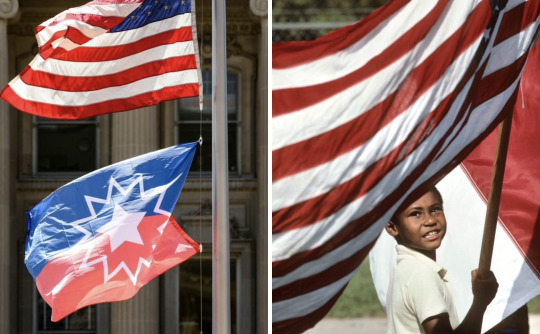


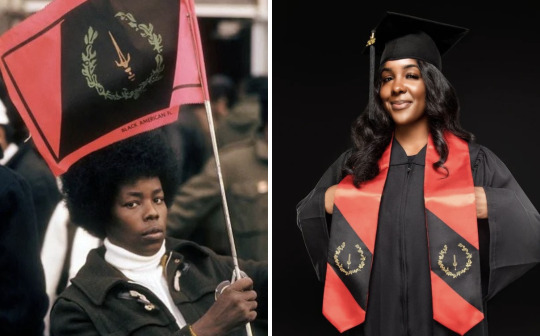
Juneteenth is a Black American holiday.
We call Juneteenth many things: Black Independence Day, Freedom Day, Emancipation Day, Jubilee Day. We celebrate and honor our ancestors.
December 31 is recognized as Watch Night or Freedom’s Eve in Black American churches because it marks the day our enslaved ancestors were awaiting news of their freedom going into 1863. On January 1, 1863, President Lincoln issued the Emancipation Proclamation. But all of the ancestors wouldn’t be freed until June 19, 1865 for those in Galveston, Texas and even January 23, 1866 for those in New Jersey (the last slave state). (It’s also worth noting that our people under the Choctaw and Chickasaw Nations wouldn’t be freed until April 28, 1866 and June 14, 1866 for those under the Cherokee Nation by way of the Treaties.)
Since 1866, Black Americans in Texas have been commemorating the emancipation of our people by way of reading the Emancipation Proclamation and coming together to have parades, free festivities, and later on pageants. Thereafter, it spread to select states as an annual day of commemoration of our people in our homeland.
Here’s a short silent video filmed during the 1925 Juneteenth celebration in Beaumont, Texas:
youtube
(It’s also worth noting that the Mascogos tribe in Coahuila, Mexico celebrate Juneteenth over there as well. Quick history lesson: A total of 305,326 Africans were shipped to the US to be enslaved alongside of American Indians who were already or would become enslaved as prisoners of war, as well as those who stayed behind refusing to leave and walk the Trail of Tears to Oklahoma. In the United States, you were either enslaved under the English territories, the Dutch, the French, the Spanish, or under the Nations of what would called the Five “Civilized” Native American Tribes: Cherokee, Creek (Muscogee), Chickasaw, Choctaw, and Seminoles. Mascogos descend from the Seminoles who escaped slavery during the Seminole Wars, or the Gullah Wars that lasted for more than 100 years if you will, and then settled at El Nacimiento in 1852.)
We largely wave our red, white and blue flags on Juneteenth. These are the only colors that represent Juneteenth. But sometimes you may see others wave our Black American Heritage flag (red, black, and gold).
Juneteenth is a day of respect. It has nothing to do with Africa, diversity, inclusion, immigration, your Pan-African flag, your cashapps, nor your commerce businesses. It is not a day of “what about” isms. It is not a day to tap into your inner colonizer and attempt to wipe out our existence. That is ethnocide and anti-Black American. If you can’t attend a Black American (centered) event that’s filled with education on the day, our music, our food and other centered activities because it’s not centered around yours…that is a you problem. Respect our day for what and whom it stands for in our homeland.
Juneteenth flag creator: “Boston Ben” Haith
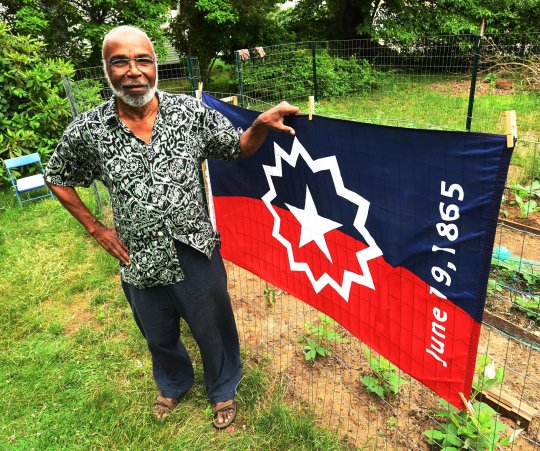
It was created in 1997. The red, white and blue colors represent the American flag. The five-point star represents the Lone State (Texas). The white burst around the star represents a nova, the beginning of a new star. The new beginning for Black Americans.
Black American Heritage Flag creators: Melvin Charles & Gleason T. Jackson

It was created in 1967, our Civil Rights era. The color black represents the ethnic pride for who we are. Red represents the blood shed for freedom, equality, justice and human dignity. Gold fig wreath represents intellect, prosperity, and peace. The sword represents the strength and authority exhibited by a Black culture that made many contributions to the world in mathematics, art, medicine, and physical science, heralding the contributions that Black Americans would make in these and other fields.

SN: While we’re talking about flags, I should note that Grace Wisher, a 13-year-old free Black girl from Baltimore helped stitched the Star Spangled flag, which would inspire the national anthem during her six years of service to Mary Pickersgill. I ain’t even gon hold you. I never looked too far into it, but she prob sewed that whole American flag her damn self. They love lying about history here until you start unearthing them old documents.
In conclusion, Juneteenth is a Black American holiday. Respect us and our ancestors.
#juneteenth#juneteenth flag#black american history#black american culture#ben haith#black american heritage flag#melvin charles#gleason t jackson#grace wisher#american flag#mascogos#juneteenth 2023
1K notes
·
View notes
Text
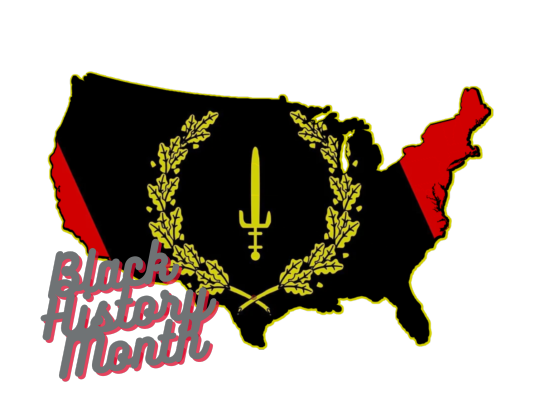
#Black History Month#BHM#Black American History#Black American Heritage Flag#tani b art#graphic design#tani b#art
18 notes
·
View notes
Text
got my Black American Heritage Flag yesterday!! i’m very happy i finally bought one. this is it on my wall:

the history and meaning behind the flag bc i think it’s quite cool: in 1967, the Black American Heritage Flag (also called the African American Heritage Flag) was created, during the civil rights movement, by Melvin Charles and Gleason T. Jackson. it served as a flag for African Americans to display our pride, celebrate our accomplishments, and honor our history. the black in the middle represents our blackness, the red represents the blood shed by black men and women in the fight for freedom and equality, and the gold represents “intellect, prosperity, and peace.” this gold comes in the form of a blunted sword and a wreath. the wreath is composed of fig leaves, which is native to Africa (not sure if all fig leaves/trees are native to Africa and idk if the flag is referencing fig leaves at large or a specific type). in the middle of the wreath is a blunted Moorish boarding sword, the sword of Moorish leaders in the 8th century (according to what i found when i looked it up, the term Moor was first used by Christian Europeans to describe muslims, typically black, in a certain region. idrk you gon have to do some research on your own for that one). this sword represents the “strength and authority” of black culture that’s contributed, and will continue to contribute, greatly to math, science, art, medicine, and other fields.
according to the BAHF wikipedia page, the idea came to Charles when he went to a parade and saw that every other group had a flag except for African Americans.
sources: https://originalblackamericanheritageflag.com & wikipedia but the link is actin up for some reason. just search up “black american heritage flag meaning” and it’ll pop up
#if you ignored this/kept scrolling you’re antiblack#black history#black americans#black american heritage flag#african american#african american history#black culture#black people#culture#african american culture#black american culture#queue me up scotty#im out of tags
24 notes
·
View notes
Text
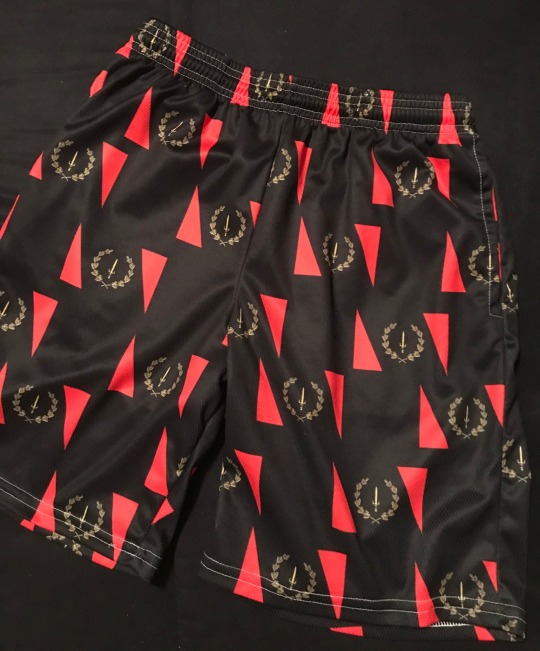
Ready for summer with my BA Pride!
2 notes
·
View notes
Text
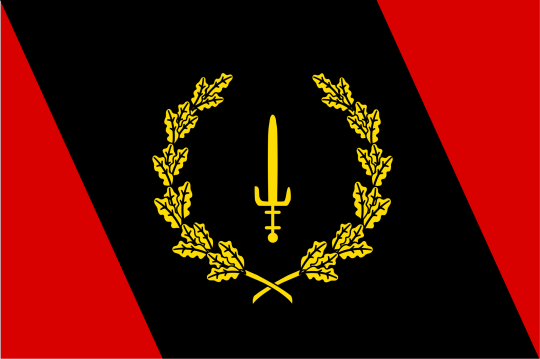
Have I mentioned that the Black American heritage flag is cool as hell? Because it rocks.
Like we need some Afrofuturist series where the flag is prominent.
8 notes
·
View notes
Text
The Meaning and History of the Black American Heritage Flag
The Black American Heritage Flag holds profound significance as a symbol of resilience, pride, and cultural heritage within the Black community. Its design is a striking representation of the diverse and rich tapestry of Black American history and experience.
The colors of the flag are deeply symbolic; red symbolizes the blood shed by ancestors in the struggle for freedom and equality, black…

View On WordPress
#African American Heritage Flag#African History#Black American Heritage Flag#Black American History#Black Empowerment#Black History
0 notes
Text
instagram

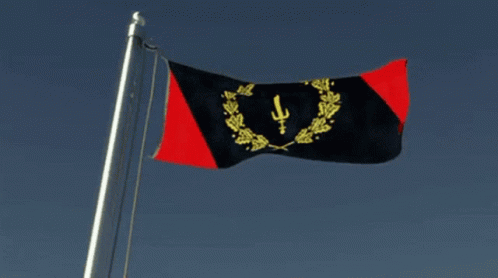

#black american heritage flag#african american heritage flag#black history month#black power#black excellence#black history
0 notes
Text

25 notes
·
View notes
Text
Our Hidden Flag
Our Heritage Flag & Crest as Black Americans by Kièl Young
What’s popping Hood Babies & Baes, I’m not gonna lie when I first discovered this, I had a mixture of feelings, and the fact that it’s kinda been hidden from us and past generations is sad. Nonetheless, it’s better to know now than not know at all. If you’re a historic nerd like myself, this post is just for you; however, even if you’re not you’ll wanna read this piece. I know personally, as a kid I grew up in a melting pot, Miami was the spot where everyone can share their culture and rep their flags to the highest, shoot one of my godfathers were Cuban. However, as I got older I always wondered why we didn’t have a flag, I mean we have the Pan-African flag but we don’t have a flag as Black Americans. That’s where the Black American Heritage Flag comes in. Scrolling through tiktok I saw two videos that really touched my heart to make this piece. A lot of us didn’t know that we have a flag, so if you’ve ever felt left out or maybe lost—don’t. Just like we have our own culture, we have our own flag as well. The Black American Heritage Flag was created and designed by Melvin Charles & Gleason T. Jackson in 1967. It’s not as mainstream as the Pan-African flag, so sadly if you’d like to get one where you can hang it, you’d have to get it personalized. Let’s break down what the flag means.The red of the flag symbolizes the blood of our people that was shed, the black in the center is the pride of our skin color, our people’s pigmentation, the wreath is the symbolism of peace, prosperity, everlasting life, and finally the sword is the pride for our heritage. Many of us don’t know about this flag, like I said I just discovered it. Having this flag is an open invitation to talk to the future generation about it, when you see others looking for their identity in their blackness, it can be hard until you realize that our culture is in everything. I’ll definitely be waving this flag this Juneteenth, to show that we’re not left out, we aren’t last. You can be prideful in this flag and it’s time that we make this flag as mainstream and popular as the Pan-African Flag. I have my Pan-African Flag in my home, and I don’t plan on taking it down at all but it’s nice to know that as a black woman in America, I have a flag. This one was short, and sweet but I promise I got another post for you coming soon, til then, stay good wid it hood fam.

#black community#black girls who write#black women#blackbeauty#blackgirlmagic#blackwriters#black heritage flag#museology#african america history#african american studies#black history#black archives#black excellence#black is beautiful#black tumblr#blackgirlswhoblog#black men#hbcu
1 note
·
View note
Text
more insight on miles’ puerto rican heritage for your fics or fanart
- traditional quinceañeras (or as they are often called by puerto ricans quinceañeros) are really not that common anymore, most girls nowadays have pool parties or go on a cruise. if miles were to go to one of his cousins’ 15 birthday party, chances are it would be casual— no big poofy dress (his mom probably had one like that though)
edit: some people disagree on this. depends on how traditional your family and friend group is I guess, as well as which part of the island you’re from. on average, it seems to be a far bigger deal amongst some other latines. in my class in pr only 3 out of approx 30 girls had a big event like that. not a single one of my cousins had a traditional quince either so you could say I’m partly biased bc of my own experiences. i personally just had a big pool party
- plantains are a big part of our diet. also, pr being an island in the caribbean, coconut is in a lot of our desserts. if miles had to pick a favorite fruit I hc he’d pick either one of the two lol also please google our food, our food isn’t actually spicy so much as savory
- we “celebrate” thanksgiving like other americans. it’s about the only time we eat oven roasted turkey. for winter holidays (christmas eve/day, new years eve/day, three kings day/eve) oven roasted pork. chicken might be offered as a second option for people who don’t consume pork for whatever reason
- you’re pretty much taught how to dance as soon as you can walk. most of us have basic rhythms down. chances of miles dancing with his mom or friends at parties? astronomically high.
- the reason why our flag is everywhere, besides pride, is ‘cause it was illegal to own it. look up the gag law that prohibited us from even displaying it at our homes. so it’s actually an awesome detail in these movies


- this is my opinion/a fun fact but I feel like miles is basically an homage to black and puerto rican (specifically nuyorican) solidarity around the 70s-80s during the creation of hip-hop and rise of graffiti as a form of expression (you can easily read up on this or watch shows like the get down to learn more about this if you’re curious)
- whether you’re “nuyorican” or “from the island” spanglish is common so miles’ mixing english and spanish isn’t odd bc even rio does this as miles points out in the party scene. he isn’t a “no sabo” kid so much as someone with a strong accent. he understands his mom perfectly
- race ≠ ethnicity. there are plenty of black people in and from Puerto Rico, and miles’ pr family in the spiderverse films are designed to be for the most part afro-latine. so I wouldn’t really call him biracial
- the puerto rican day parade wouldn’t be a thing he skips, he’s gifted a special suit for it in a comic run. his puerto rican heritage is important to him!
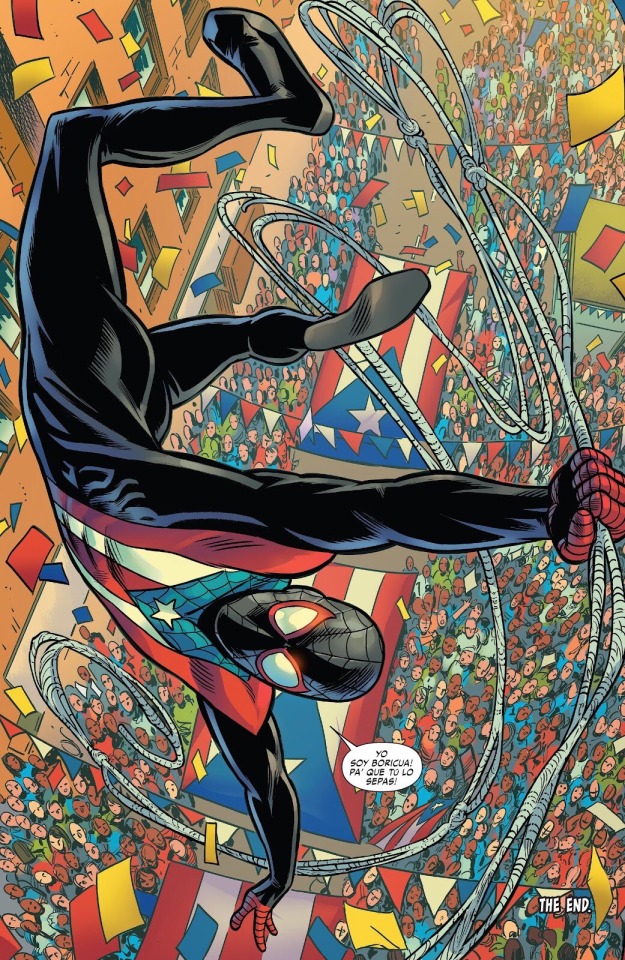
#if you’re writing and need cultural insight i don’t mind messages hhhhh#what he represents matters a lot to me#spiderverse#miles molares#spiderman#punkflower#gwiles#flowerbyte
4K notes
·
View notes
Text
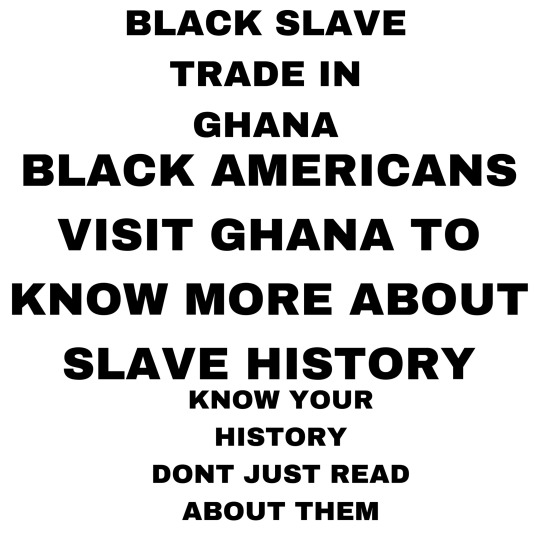
Black Americans should visit Ghana
To know more about black slave trade in Ghana

Monuments of shame
Cape Coast Castle - now a World Heritage Site - is one of about forty forts in Ghana where slaves from as far away as Burkina Faso and Niger were imprisoned. This former slave fortress could hold about 1,500 slaves at a time before they were loaded onto ships and sold into slavery in the New World in the Americas and the Caribbean.

Male captives who revolted or were deemed insubordinate ended up in the condemned cells - a pitch-black room where slaves were left to die in the oppressive heat without water, food or daylight.Rebellious women were beaten and chained to cannon balls in the courtyard
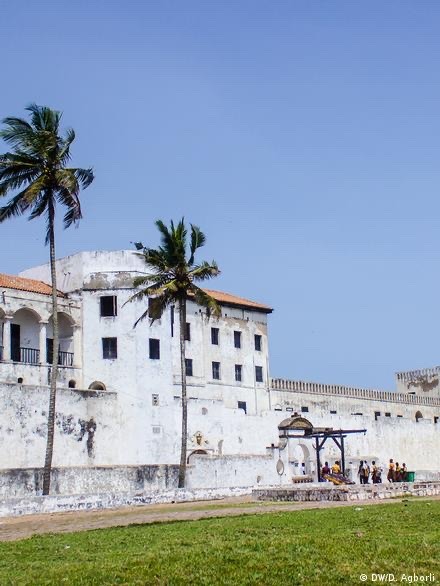
Built in 1482, Elmina Castle on Ghana's Cape coast is the earliest European structure erected in sub-Saharan Africa. Originally Portugese, it was later captured by the Dutch, who used it as a base for the Dutch slave trade with Brazil and the Caribbean. Under the flag of the Dutch West Indies Company, around 30,000 slaves a year passed through Elmina until 1814 when the Dutch abolished slavery.
The Portuguese position on the Gold Coast remained secure for almost a century. During that time, Lisbon leased the right to establish trading posts to individuals or companies that sought to align themselves with the local chiefs and to exchange trade goods both for rights to conduct commerce and for slaves whom the chiefs could provide. During the seventeenth and eighteenth centuries, adventurers--first Dutch, and later English, Danish, and Swedish-- were granted licenses by their governments to trade overseas. On the Gold Coast, these European competitors built fortified trading stations and challenged the Portuguese. Sometimes they were also drawn into conflicts with local inhabitants as Europeans developed commercial alliances with local chiefs.
The principal early struggle was between the Dutch and the Portuguese. With the loss of Elmina in 1642 to the Dutch, the Portuguese left the Gold Coast permanently. The next 150 years saw kaleidoscopic change and uncertainty, marked by local conflicts and diplomatic maneuvers, during which various European powers struggled to establish or to maintain a position of dominance in the profitable trade of the Gold Coast littoral. Forts were built, abandoned, attacked, captured, sold, and exchanged, and many sites were selected at one time or another for fortified positions by contending European nations.
Both the Dutch and the British formed companies to advance their African ventures and to protect their coastal establishments. The Dutch West India Company operated throughout most of the eighteenth century. The British African Company of Merchants, founded in 1750, was the successor to several earlier organizations of this type. These enterprises built and manned new installations as the companies pursued their trading activities and defended their respective jurisdictions with varying degrees of government backing. There were short-lived ventures by the Swedes and the Prussians. The Danes remained until 1850, when they withdrew from the Gold Coast. The British gained possession of all Dutch coastal forts by the last quarter of the nineteenth century, thus making them the dominant European power on the Gold Coast.
During the heyday of early European competition, slavery was an accepted social institution, and the slave trade overshadowed all other commercial activities on the West African coast. To be sure, slavery and slave trading were already firmly entrenched in many African societies before their contact with Europe. In most situations, men as well as women captured in local warfare became slaves. In general, however, slaves in African communities were often treated as junior members of the society with specific rights, and many were ultimately absorbed into their masters' families as full members. Given traditional methods of agricultural production in Africa, slavery in Africa was quite different from that which existed in the commercial plantation environments of the New World.
Another aspect of the impact of the trans-Atlantic slave trade on Africa concerns the role of African chiefs, Muslim traders, and merchant princes in the trade. Although there is no doubt that local rulers in West Africa engaged in slaving and received certain advantages from it, some scholars have challenged the premise that traditional chiefs in the vicinity of the Gold Coast engaged in wars of expansion for the sole purpose of acquiring slaves for the export market. In the case of Asante, for example, rulers of that kingdom are known to have supplied slaves to both Muslim traders in the north and to Europeans on the coast. Even so, the Asante waged war for purposes other than simply to secure slaves. They also fought to pacify territories that in theory were under Asante control, to exact tribute payments from subordinate kingdoms, and to secure access to trade routes--particularly those that connected the interior with the coast.
It is important to mention, however, that the supply of slaves to the Gold Coast was entirely in African hands. Although powerful traditional chiefs, such as the rulers of Asante, Fante, and Ahanta, were known to have engaged in the slave trade, individual African merchants such as John Kabes, John Konny, Thomas Ewusi, and a broker known only as Noi commanded large bands of armed men, many of them slaves, and engaged in various forms of commercial activities with the Europeans on the coast.
The volume of the slave trade in West Africa grew rapidly from its inception around 1500 to its peak in the eighteenth century. Philip Curtin, a leading authority on the African slave trade, estimates that roughly 6.3 million slaves were shipped from West Africa to North America and South America, about 4.5 million of that number between 1701 and 1810. Perhaps 5,000 a year were shipped from the Gold Coast alone. The demographic impact of the slave trade on West Africa was probably substantially greater than the number actually enslaved because a significant number of Africans perished during slaving raids or while in captivity awaiting transshipment. All nations with an interest in West Africa participated in the slave trade. Relations between the Europeans and the local populations were often strained, and distrust led to frequent clashes. Disease caused high losses among the Europeans engaged in the slave trade, but the profits realized from the trade continued to attract them.
The growth of anti-slavery sentiment among Europeans made slow progress against vested African and European interests that were reaping profits from the traffic. Although individual clergymen condemned the slave trade as early as the seventeenth century, major Christian denominations did little to further early efforts at abolition. The Quakers, however, publicly declared themselves against slavery as early as 1727. Later in the century, the Danes stopped trading in slaves; Sweden and the Netherlands soon followed.
The importation of slaves into the United States was outlawed in 1807. In the same year, Britain used its naval power and its diplomatic muscle to outlaw trade in slaves by its citizens and to begin a campaign to stop the international trade in slaves. These efforts, however, were not successful until the 1860s because of the continued demand for plantation labor in the New World.
Because it took decades to end the trade in slaves, some historians doubt that the humanitarian impulse inspired the abolitionist movement. According to historian Walter Rodney, for example, Europe abolished the trans-Atlantic slave trade only because its profitability was undermined by the Industrial Revolution. Rodney argues that mass unemployment caused by the new industrial machinery, the need for new raw materials, and European competition for markets for finished goods are the real factors that brought an end to the trade in human cargo and the beginning of competition for colonial territories in Africa. Other scholars, however, disagree with Rodney, arguing that humanitarian concerns as well as social and economic factors were instrumental in ending the African slave trade.
#life#culture#black history#blm blacklivesmatter#history#animals#architecture#aesthetic#black community#anime and manga#blacklivesmatter#humiliation slave
153 notes
·
View notes
Text
anyway befire i sleep some of my favourite sapnap lore
- the whole keeping dream on standby via airpods bc he has women in his vicinity . pathetic i love him
- tried to piss in a cup while driving to florida to live with dream. failed pissed all over the car.
- was a straight a student and used to get in trouble for playing minecraft instead of studying to the point where he was low-key trauma dumping in stream about it
- convinced he can take a bear in a fight
- the fact that i wanna see some ass became associated with him
- he ‘stole’ the dream team channel (inactive) 100k play button
- his favourite flowers are the blue bonnet which is the texas state flower AND he had a texas flag hanging in his old bedroom texas pride okay
- the paris bedsheets
- when he showed up to irls during the first karlnap meetup with an acne scar under his eye and managed to have everyone convinced for like 3 days it was a black eye befire telling us it was an acne scar
- when he went through his white american phase of making sure everyone knew his heritage and started speaking and singing greek in every basketball stream
- recorded a dream minecraft challenge video high
- went through a phase where 90% of his on steam conversations were about whether or not he could take chat in a fight . this was spurred on by chat and donos
ok gn
253 notes
·
View notes
Text

We're getting ready for Black History Month now!
#Black History Month#BHM#Black American Heritage Flag#BAH#BAH Flag#Accented Dialect#clothing#Black owned
3 notes
·
View notes
Text
The American flag as a lot of variations, with new ones being created all the time. In recent years, a new version of the flag has popped up and made waves across the political and social spheres. The Black American Flag is a unique variation of the American flag, and today we are going to be talking about what it means, where it came from, and some of the historical elements that have influenced it today. Additionally, we are going to topically cover some of the political influences that surround the flag and some of the controversies surrounding it. Let’s get started.
The Black American Flag

©Deacons docs/Shutterstock.com
The Black American Flag is a variation of the U.S. flag that replaces all the colors with black. It is often seen as a symbol of resistance, defiance, or protest against the government or the status quo. However, black flags have a darker and more violent history in the past, especially in relation to the concept of “no quarter”. “No quarter given” is a phrase that means there will be no negotiation, no peace, no surrender, and there will be a fight to the death to the last man. Thus, the black flag was the opposite of the white one, which famously signal a desire for peace and negotiation.
Many experts think that black flags were first used by pirates in the 18th century to indicate that they would not spare or take prisoners of any enemy ship that resisted them. Currently, there are some rumors about Confederate units carrying black American flags during the American Civil War, but historians are saying this is more myth than fact.
The Black American Flag may be seen as a modern adaptation of this historical tradition related to “no quarter” language, but it also carries different meanings for different people. Some may use it as a way of expressing their dissatisfaction with the current political or social situation, while others may use it as a threat or a warning to their perceived enemies.
Where Did the Black American Flag Originate?

©Andrejs Marcenko/Shutterstock.com
The Black American Flag, as we know it today, is a relatively recent creation that has different meanings depending on the context and the person who displays it. However, it also draws inspiration from older traditions and symbols that have been used by various groups throughout history. One of the earliest origins of the Black American Flag can be traced back to the 18th century, when black flags were used by pirates to signal that they would not spare or take prisoners of any enemy ship that resisted them. This was also known as the “no quarter” flag , meaning that no mercy would be given or expected in battle.
In modern times, the black American flag has been used to convey a message of resistance, defiance, or protest against the government or the status quo. Some people use it as a way of expressing their dissatisfaction with the current political or social situation, while others use it as a threatening way of communicating certain political ideologies.
There are two versions of black American flags. The first are those that are all black without any features. The second are those that are all black except for a blue square with red stripes. The first is also known as the “Thin Blue Line” flag, which is used to signify support for law enforcement. However, this flag has also been criticized as a symbol of backlash against the fight for racial justice and the Black Lives Matter movement.
The Black American Flag may also be confused with another flag that has a similar name but a different design: The Black American Heritage Flag. This flag was designed in 1967 by M. Charles and G. Jackson to show pride in the history of Black Americans. It visually displays one diagonal black stripe centered between two red stripes, along with a sword circled by a golden wreath of leaves.
The Meaning of the Black American Flag
The meaning of the Black American Flag is not fixed or universal but rather depends on the context and the intention of the person who displays it. However, some common themes and ideas that are often associated with this flag are resistance, defiance, protest, and no quarter.
In modern times, black flags have been used by v arious groups and individuals to convey a message of resistance, defiance, protest, or no quarter against the government or the status quo, such as Trump supporters, anarchists, Black Lives Matter activists, or anti-fascists. The Black American Flag is a symbol that has multiple and sometimes contradictory meanings, depending on who uses it and why.
Controversy Around the Black American Flag

©Leonard Zhukovsky/Shutterstock.com
The Black American Flag is not without controversy. Some argue that it is disrespectful to the American flag and the values that it represents. These people argue that it is a symbol of division rather than unity and that it sends a negative message to those who have served and sacrificed for their country. Some may also see it as a sign of extremism or violence, especially if it is associated with groups or movements that advocate for armed resistance or overthrowing the government. Some may also see it as a sign of racism or hatred, especially if it is used to oppose or intimidate groups or individuals that are fighting for racial justice or equality.
It’s important to know that the Black American Flag isn’t a neutral or harmless symbol and can provoke strong reactions and emotions from different people.
Is it Illegal to Fly a Black American Flag?

©Wirestock Creators/Shutterstock.com
The Black American Flag, as a symbol that can be interpreted in different ways by different people, may also raise some questions about its legality and appropriateness. Is it illegal to fly a Black American Flag? The answer is no, but it may not be respectful either. Being illegal and being respectful isn’t necessarily the same thing.
According to the U.S. Flag Code, which is a set of guidelines for displaying and handling the American flag , the Black American Flag is not an official version of the flag. The Flag Code also states that the flag should not be used for advertising purposes, as a costume or athletic uniform, or as a receptacle for anything. The Flag Code also states that no disrespect should be shown to the flag, and that it should not be dipped to any person or thing. Still, with all that code in mind, it’s important to know that the rules around displaying the American flag and its variations, including the Black American Flag, are not legally enforceable.
In the United States , these codes are considered as a matter of etiquette and tradition, not law. Therefore, flying a Black American Flag is not illegal, but it may be seen as disrespectful or inappropriate by some people, especially those who value the flag and what it represents.
43 notes
·
View notes
Text
Appeasement does not work.

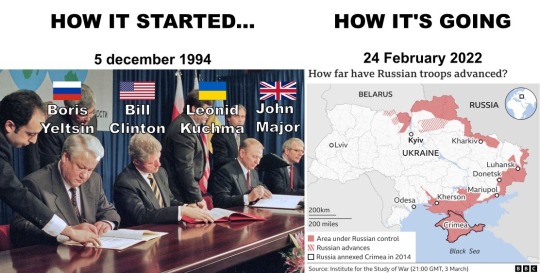

Appeasement didn’t work for Hitler, appeasement didn’t work after the Budapest Memorandum, appeasement didn’t work for Crimea and Dunbas, and appeasement won’t work now.
This is not about “denazification” of Ukraine. Remember, Russia has Nazis, and so does America and many other nations. Is Putin going to attack all of them too?
To be clear: Obviously I am NOT excusing Nazis anywhere, but much like the Jewish Holocaust survivors who were happily living in Odesa Ukraine—who do not welcome Putin’s alleged Russian saviors—as a Black man, I too would be kinda pissed if Russia started indiscriminately bombing tf outta my neighborhood to “denazify” it (and that’s despite the fact that I saw a ton of Trump flags in my hood during the last two election cycles). It’s bullshit. Russia recently used an antisemitic “argument” to disregard Zelenskyy’s Jewish heritage. It’s a bullshit argument. Putin wants to “denazify” Ukraine, about as much as George W. Bush wanted to bring “democracy” to Iraq, Afghanistan and every other country we’ve invaded.
Mikhail Gorbachev himself said that NATO expansion was never an issue. It’s revisionist history to say otherwise, but that’s not stopping Putin from using it as his current go to argument. Crimea was not a member of NATO, and Ukraine was not in NATO nor seeking membership when Putin attacked. And tomorrow, it will be some brand new bullshit excuse. But make no mistake: Putin is invading Ukraine and committing war crimes for the exact same reasons all colonizing imperialists do—for dominance, power, land and resources.
Russian imperialism isn’t good just because American imperialism is bad.
And for the “communist” tankies suddenly simping for Henry Kissinger—a U.S. war criminal they hated until last week—all I have to say is this: telling people who were peacefully minding their own business, to “just stop fighting back if you want to end the war,” has got to be some of the vilest shit I’ve seen in a good long minute. Except, I see this mentality all the time. It’s the foreign policy equivalent of telling Black and Brown people to “be peaceful” and maybe the cops will stop attacking you. It’s the equivalent of advising a battered wife to please, “just try not to provoke your abuser, and maybe he’ll stop hitting you.” It is literally endorsing “might makes right.” It’s abuser logic. It’s gaslighting. It’s bullshit advice that has never ever ever worked for anyone smaller who is being systematically harassed or attacked by a more powerful abuser.
“Just give the bully your lunch money today” is terrible advice, it only ensures that the bully will expect to keep on taking your lunch money every single day.
Obviously, no sane person wants any war to continue, but what kind of world do we want to live in if we keep telling smaller countries to just acquiesce to larger countries who invade and attack them, unprovoked?
#politics#budapest memorandum#appeasement#ukraine#tankies#russia#nato#russian imperialism#no war#russian colonialism#bullies#vladimir putin#little putler#adolph putin
359 notes
·
View notes
